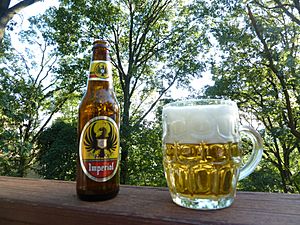Beer in Costa Rica facts for kids
Costa Rica is known for its strong drink-making industry, especially for popular Lager style drinks. One famous brand, Imperial beer, is made by a company called Florida Ice & Farm Co.. It's recognized all over the world as a symbol of Costa Rica.
Because of where Costa Rica is located, it can't grow all the special ingredients needed to make these drinks. This means the country relies a lot on ingredients brought in from other places.
Contents
A Look Back: History of Drinks in Costa Rica
The story of drink making in Costa Rica began a long time ago. In February 1852, a special permission to open a brewery was granted. By April 1856, newspapers were already advertising "Torres Beer," made from barley and hops. This early business closed by 1861.
In 1867, two men, James Hasland and Arthur Kopper, opened a brewery in Cartago. The next year, in 1868, the President of Costa Rica, José María Castro Madriz, asked Karl Johanning to build another brewery in San José. This one was run by the government to help raise money during a tough time for coffee farmers.
By the late 1800s, at least six different breweries were making drinks in San José and Cartago. One of them, "Cervecería del León," could produce up to 7,500 bottles every day in 1885!
A man named José Traube Tichy, from Bohemia, started "Cervecería Globo" (Globe Brewery) in Cartago in 1888. This company moved around a few times in San José. It eventually became "Gran Cervecería Traube" and was famous for using water from the Torres river. They even had special mules to carry their drinks! This brewery made popular drinks like Pilsen Traube.
On September 16, 1908, three brothers from Jamaica, Rupert, Cecilio, and Stanley Lindo Morales, started a company called Florida Ice & Farm Co. in Siquirres, Limón Province. At first, they mainly produced ice and farm goods.
In 1912, Florida Ice & Farm Co. bought "Gran Cervecería Traube." This was how they started making their own drinks. The popular Pilsen drink we know today comes from the old Pilsen Traube. "Gran Cervecería Traube" closed in 1966.
Another family from Spain, the Ortegas, started making drinks in 1914. They used special spring water from Salitral, Santa Ana. They created the Imperial and Bavaria drinks. In 1957, Florida Ice & Farm Co. bought the Ortega brewery and still makes Imperial and Bavaria today.
In the 1930s, "Cervecería Gambrinus" was started by people who had moved to Costa Rica from Europe. Later, "Cervecería Tropical" was founded by Cuban immigrants. Florida Ice & Farm Co. slowly bought parts of this company, finally owning it completely in 1988. This meant that one company made most of the drinks in Costa Rica.
The Rise of Craft Drinks in Costa Rica
For a long time, it was hard to find different kinds of locally made drinks in Costa Rica, other than those from Florida Ice & Farm Co. This meant there weren't many choices. It was also difficult because there weren't many local ingredients, and the rules for small drink makers weren't very clear.
The restaurant K&S in Curridabat, which opened in 1997, was one of the first to make its own special drinks for people to try. They continued making their "Chivo Blanco" and "K&S Lager" until 2009.
The first small, special drink pub in Costa Rica was called Cabeza Grande. It opened in San Jose in 1998. Later, it moved to Lake Arenal in 2010 and became Lake Arenal Brewery. This brewery is special because it uses solar power for all its operations, gets water from a spring, and even recycles leftover grain for its farm!
Then, in 2010, a company called Costa Rica Craft Beer Co. really kicked off the trend. They started making their own brands, "Segua" and "Libertas." After this, many other small drink makers, called microbreweries, started to appear. Many of them were helped by people from the United States who had experience making these kinds of drinks.
Around 2012, some companies like TicoBirra and La Bodega de Chema started selling the ingredients (like malt, hops, and yeast) and tools needed to make drinks at home. They also taught workshops on how to do it. This helped even more new small drink makers get started.
Since 2012, there has been a "Festival de Cerveza Artesanal" (Craft Beer Festival). This event shows off all the new and different drinks being made. The festival grew from 400 people attending in its first year to about 3000 in 2014! This shows how much people in Costa Rica started to enjoy these new kinds of drinks.
By 2014, the small drink makers had become so popular that Florida Ice & Farm Co. decided to start its own special drink division, called La Micro Brewing Company.
Name Challenges
In 2013, a small drink maker called El Búho Cervecería Artesanal started selling its drink, "Búho." However, they hadn't officially registered the name. In 2014, Florida Ice & Farm Co.'s new division, La Micro Brewing Company, also started making a drink called "Búho" and registered the name. This led to a disagreement over who owned the name. In the end, the official office in Costa Rica gave the name "Búho" to Florida Ice & Farm Co. El Búho Cervecería Artesanal then changed its name to Bora Brewing Company.
See also
 In Spanish: Cerveza de Costa Rica para niños
In Spanish: Cerveza de Costa Rica para niños


